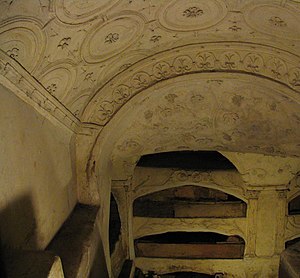Catacombs of San Sebastiano
| Catacombe di San Sebastiano | |
 |
|
| Location | Rome, Via Appia Antica |
|---|---|
| Type | Catacombs |
| History | |
| Founded | Late antiquity |
| Management | Pontifical Commission of Sacred Archaeology |
The Catacombs of San Sebastiano are a hypogeum cemetery in Rome (Italy), rising along Via Appia Antica, in the Ardeatino Quarter. They are one of the very few Christian burial places that have always been accessible. The first of the former four floors is now almost completely destroyed.
In ancient times the catacombs were simply known with the name in catacumbas, a Greek term composed by two words, katà and kymbe, literally meaning "close to the cavity". Actually, along the Appian Way, close to the cemetery, an evident dip in the ground is visible even now. Moreover, before its employment as a burial ground, the area was occupied by pozzolan mines, now placed about ten meters above the floor of the Basilica of San Sebastiano fuori le mura: these mines gave rise to a pagan cemetery, then used by Christians. The word catacumbas, through a process of extension and assimilation, was gradually used to identify all the hypogeum burial sites, thus simply called catacombs.
The underground graveyard, called di San Sebastiano since the Early Middle Ages, was known since the 3rd century as in memoria apostolorum, a toponym referred to the presence within the catacomb, for some time, of the relics of the Apostles Peter and Paul. In effect, the Depositio Martyrum (half of the 4th century), at the date of 29 June, talks about the recurrence of Peter in catacumbas and Paul on Via Ostiensis. The Martyrologium Hieronymianum (5th century), at the same date, cites the recurrence of Peter in Vatican, Paul on Via Ostiensis and utrumque in catacumbas, Tusco et Basso consulibus (during the consulship of Tuscus and Bassus, that is in 258).
Ancient sources attest the presence of three martyrs within the cemetery on the Appian Way: Sebastian, Quirinus and Eutychius. The names of the martyrs are mentioned in a 7th-century catalogue, called Notula oleorum, while the Early Middle Ages itineraries for pilgrims do not cite Eutychius, because its sepulchre was hard to reach.
...
Wikipedia
